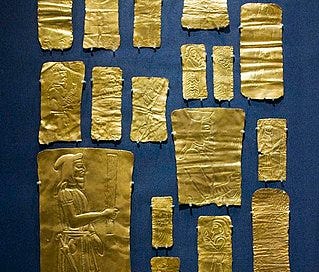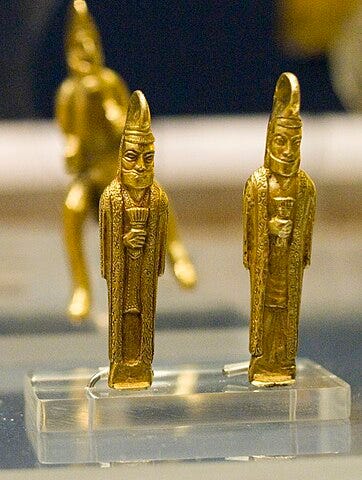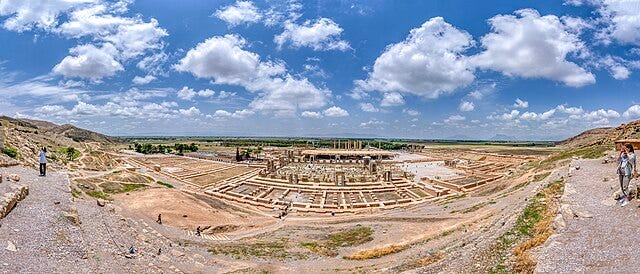Today I’m sharing my thoughts on the sixth fortnight of our adapted version of Ted Gioia’s Course in Humanities.
You can find previous parts of this course at the end of this post.
For now, we’ll discuss:
a) Persian art and architecture.
b) Nonesuch Explorer recordings of traditional music from Japan, Tibet, Iran, and Indonesia.
c) Plato: Symposium and Herodotus: The Histories (Books 1, 6-8).
Persian art and architecture
At first I struggled a bit with the chronology and sheer vastness of the subject.
Ted left us some supporting material, but there is so much more to look at.
The history of Persian art and architecture is long (c. 550 BCE and 651 CE), from the Achaemenid Empire to the Sassanian Empire. It was influenced by many civilizations that came before — Mesopotamian, Assyrian, Egyptian, Greek and particularly the Elam and Susiana traditions.
The most famous collection of Persian artifacts is probably the Oxus Treasure1, dated between c. 550–330 BCE. It consists of plaques, figurines/statuettes of human beings and animals, vessels, rings, seals, chariots with horses and figures. Most of the pieces were made with gold or silver.
The heart of what is left of Persian architecture has got to be Persepolis, located in modern-day Iran.
Persepolis (city of the Persians) was “constructed”2 by Darius the Great (c. 550 – 486 BCE) and used as the ceremonial capital of the Achaemenid Empire (c. 550–330 BCE). In addition to the construction of many cities and monuments,Darius the Great is remembered for his roads, monetary system, standard weights and measures and ruling the largest empire of his time.
The study of Persepolis also helped with the modern rediscovery of cuneiform writing. It has been a UNESCO World Heritage Site since 1979.
The oldest remains of the city (complex?) date back to c. 515 BCE. Though its precise functions remain unclear, it seems that Persepolis hosted many governance and ceremonial activities until the place was conquered by the Alexander the Great in 330 BCE.
The Achaemenid Empire was followed by the Seleucid Empire (Seleucus I Nicator was one of Alexander’s generals), which increased Greek influence in the area. Then came the Parthians, the Sassanians and many others who build upon the foundantion laid out by Achaemenid Empire.
Achaemenid architects and sculptors designed many cities, temples, mausoleums, tombs, irrigation systems, gardens3, and their work had a profound effect on Iranian and Islamic culture.
Nonesuch Explorer


Ted’s recommendation for Japanese music was Shakuhachi: The Japanese Flute (picture on the right), which I liked, but not as much as Traditional Vocal & Instrumental Pieces (on the left).
Not only is it more varied, I feel like represents better what I normally associate with Japanese music. So if you have to pick one, that’s what I would recommend (they also have other albums of Japanese music, it’s definitely worth browsing).
My favorite, however, must be Persian Classical Music.
It gave me a similar experience to the one I had listening to The Hugo Masters, as if I had travelled in time and space to place I had never been before, but the novelty was less familiar (I realized I know a lot more about China than Iran).
Sadly I did not enjoy the Ted’s album of choice for Indonesian music. Some note were so high they were almost shrill and made my teeth grind.
But the one I enjoyed the least was the Tibetan album.
Some parts of it were quiet, contemplative, others were a loud mix of plates, drums and (I believe) horns. I was very confused.
To be fair, I have very little contact Buddhism, so maybe I lack the cultural background to understand why certain things sound/are performed in this way.
Symposium
As we’ve discussed before, I’m not a Plato kind of girl. Unsurprisingly, I did not enjoy Symposium.
It’s another Socratic dialogue and the topic of discussion is Love.
Apollodorus tells a story he heard from Aristodemus about a party (symposium)4 attended by prominent figures of Athenian society.
Phaedrus suggests each person should make a speech in praise of Eros. He says Love is one of the oldest of the gods and promotes virtue in people. Pausanias sets Common (simples desire) and Heavenly (between a man and a boy5) Love apart. The third is the physician, Eryximachus, who claims Love promotes harmony and moderation in all things (people, music, medicine).
Aristophanes, one of the playwrights we’ll talk about on Fortnight #10, is next (and seems to make fun of the whole thing, as he usually does). His speech is a mythological tale about men and women being one until they were separated by the Gods and doomed to keep looking for their other half.
Agathon says Love is young, beautiful, sensitive, wise, and inspires virtue in us. Socrates argues those things are object of Love, not Love itself, and begins to tell the audience about Diotima’s teachings6.
According to her, Love is a spirit, not a god. Love is represented by the desire for wisdom and beauty and expressed through reproduction (sexual or intelectual). Here Plato goes back to his theory of Forms — we should strive to achieve the knowledge of the Form Beauty.
Then Alcibiades, who has a unrequited crush on Socrates, walks in drunk and creates scene. People keep on talking and drinking and Socrates goes about his day.
Symposium is probably Plato’s most dramatic work, it sounds just like a play. Philosophically, it conveys the Theory of Forms and his ideas about Love (the pursuit of knowledge and wisdom), offering (and somewhat ridiculing) contrasting opinions.
Personally I didn't get much out it. It is a historical text and a foundation for posterior discussions, so it was worth reading.
The Histories
This was a huge disappointment.
I was expecting to love The Histories. Its nine books focus on the Greeks and other Mediterranean civilizations, key points of their history (a lot of it consists of things Herodotus “heard” during his voyages) and conflicts.
I like reading about ancient history, but Herodotus didn’t work for me.
At first I thought it might be a translation problem, so I tried another one. I also tried two audiobooks versions to see if a nice narration could get me going. Sadly, the text still fell flat.
I felt like I was just lising to a bunch of of names and events — it lacked both academic rigor and methodology, present in modern history books, and narrative allure, as one would find in historical fiction. The fact that I know a lot of he says is not based or contradicts archeological findings didn't help either.
Since the book is too long (and boring) to read for mere historical curiosity (the guy is the father of History after all), I decide to stick with the parts (books) Ted recommended (1, 6-8), but even that was difficult.
However, I’ve not given up completely. I plan to try again in the future just to be sure the probelm wasn’t my current mood.
This is it for today.
I hope you’ll join me for next fortnight.
In case you haven't read them, here are parts One, Two, Three, Four and Five.
Discovered on the north bank of the Oxus River in Tajikstan between 1876-1880 CE. Most pieces, made of precious metal, can be found at the British Museum, London.
The plans were completed by his son, Khshayarsa or Xerxes I, best known in the West for his invasion of Greece in 480 BCE. Herodotus wrote a lot about him.
It seems the Persian word for garden “pairi-daeza” might have originated the word “paradise”.
A symposium was a social gathering in which male aristocrats would drink, talk (usually philosophical and political themes) and be entertained (music, poetry, dance, games).
I suggest reading about pederasty in Ancient Greece.
Due to the lack of evidence, we can't tell if Diotima of Mantinea was just a character in Symposium or an actual historical figure. Described by Socrates (Plato) as a wise woman, some scholars argue she was priestess, which would give her certain authority regarding matters of religion and virtue. Her ideas about Love are the origin of what we call Platonic love.











